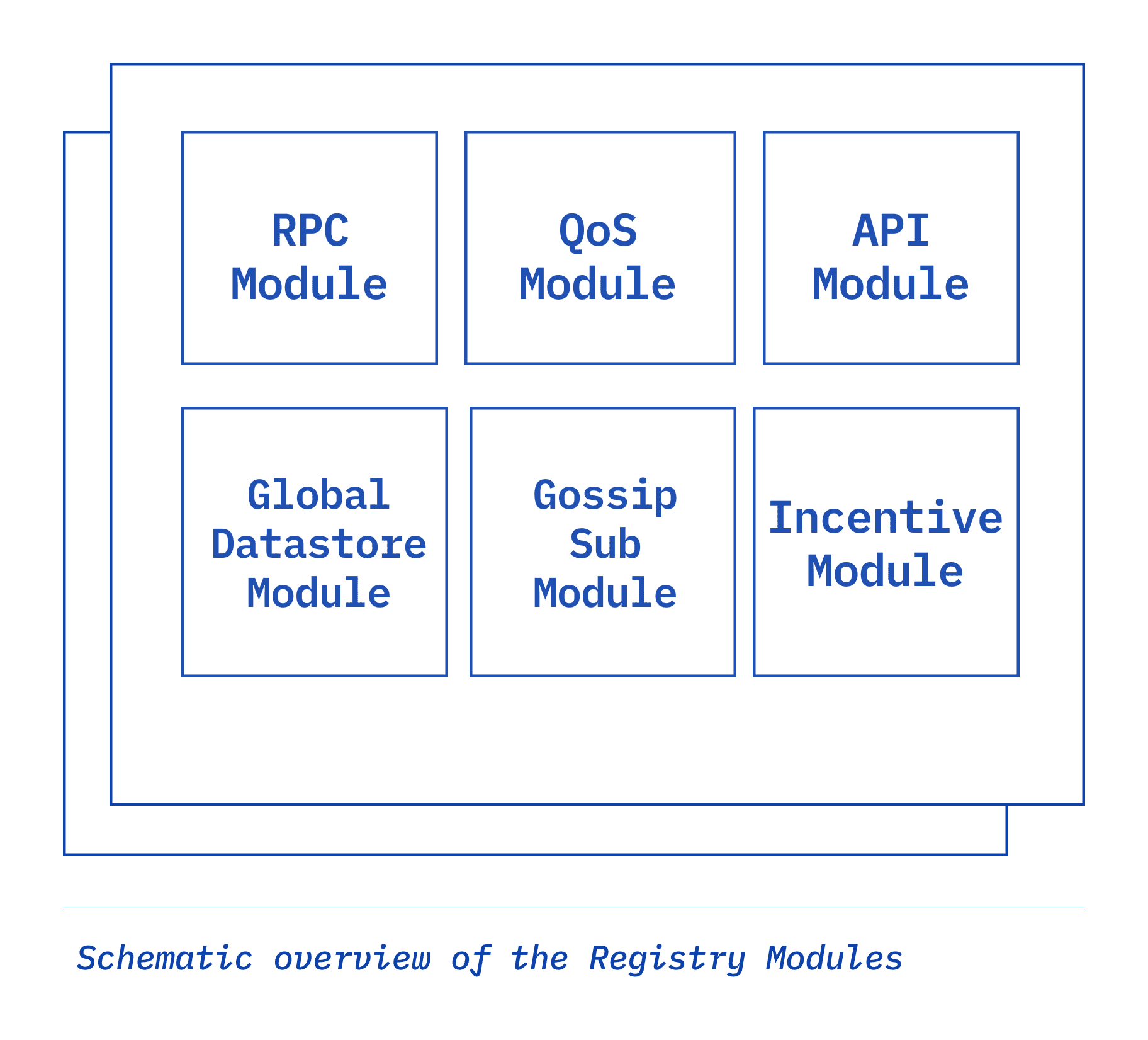Registry Network
Registry Network
Registry Network
Registry Network




The Registry is the entry point for Media Nodes and Orchestrators in the dRTC Network. It ensures system components can find each other and maintain observability across a distributed infrastructure. It serves as a data store and conducts node management, data storage, and network operations. It consists of the following modules:
The Registry is the entry point for Media Nodes and Orchestrators in the dRTC Network. It ensures system components can find each other and maintain observability across a distributed infrastructure. It serves as a data store and conducts node management, data storage, and network operations. It consists of the following modules:
The Registry is the entry point for Media Nodes and Orchestrators in the dRTC Network. It ensures system components can find each other and maintain observability across a distributed infrastructure. It serves as a data store and conducts node management, data storage, and network operations. It consists of the following modules:
The Registry is the entry point for Media Nodes and Orchestrators in the dRTC Network. It ensures system components can find each other and maintain observability across a distributed infrastructure. It serves as a data store and conducts node management, data storage, and network operations. It consists of the following modules:
PubSub Module
The PubSub module for the Registry Network uses a gossip protocol to propagate messages and is responsible for two primary functions:
PubSub Module
The PubSub module for the Registry Network uses a gossip protocol to propagate messages and is responsible for two primary functions:
PubSub Module
The PubSub module for the Registry Network uses a gossip protocol to propagate messages and is responsible for two primary functions:
PubSub Module
The PubSub module for the Registry Network uses a gossip protocol to propagate messages and is responsible for two primary functions:
1. Bootstrapping New Registry Nodes
When a new registry node joins the network, the PubSub Module facilitates its integration by connecting it to existing nodes and sharing essential network information
1. Bootstrapping New Registry Nodes
When a new registry node joins the network, the PubSub Module facilitates its integration by connecting it to existing nodes and sharing essential network information
1. Bootstrapping New Registry Nodes
When a new registry node joins the network, the PubSub Module facilitates its integration by connecting it to existing nodes and sharing essential network information
1. Bootstrapping New Registry Nodes
When a new registry node joins the network, the PubSub Module facilitates its integration by connecting it to existing nodes and sharing essential network information
2. Facilitating Communication between Registry Nodes
Ensuring that all nodes have up-to-date information about the network’s state which is important for maintaining an accurate and current list of Media Nodes.
2. Facilitating Communication between Registry Nodes
Ensuring that all nodes have up-to-date information about the network’s state which is important for maintaining an accurate and current list of Media Nodes.
2. Facilitating Communication between Registry Nodes
Ensuring that all nodes have up-to-date information about the network’s state which is important for maintaining an accurate and current list of Media Nodes.
2. Facilitating Communication between Registry Nodes
Ensuring that all nodes have up-to-date information about the network’s state which is important for maintaining an accurate and current list of Media Nodes.
DataStore Module
The DataStore Module stores information about Media Nodes and their at- tributes. It uses Conflict-Free Replicated Data Types (CRDTs) to ensure data consistency across the network and uses distributed data storage across the network, enhancing data backup, availability, and resilience.
DataStore Module
The DataStore Module stores information about Media Nodes and their at- tributes. It uses Conflict-Free Replicated Data Types (CRDTs) to ensure data consistency across the network and uses distributed data storage across the network, enhancing data backup, availability, and resilience.
DataStore Module
The DataStore Module stores information about Media Nodes and their at- tributes. It uses Conflict-Free Replicated Data Types (CRDTs) to ensure data consistency across the network and uses distributed data storage across the network, enhancing data backup, availability, and resilience.
DataStore Module
The DataStore Module stores information about Media Nodes and their at- tributes. It uses Conflict-Free Replicated Data Types (CRDTs) to ensure data consistency across the network and uses distributed data storage across the network, enhancing data backup, availability, and resilience.
Data Consistency and Storage
Data Consistency and Storage
Data Consistency and Storage
Data Consistency and Storage
1. CRDTs for Consistency
CRDTs prevent conflicts during concurrent updates, maintaining data integrity in the distributed environment.
1. CRDTs for Consistency
CRDTs prevent conflicts during concurrent updates, maintaining data integrity in the distributed environment.
1. CRDTs for Consistency
CRDTs prevent conflicts during concurrent updates, maintaining data integrity in the distributed environment.
1. CRDTs for Consistency
CRDTs prevent conflicts during concurrent updates, maintaining data integrity in the distributed environment.
2. High-Performance Storage
A key-value store optimized for fast operations.
2. High-Performance Storage
A key-value store optimized for fast operations.
2. High-Performance Storage
A key-value store optimized for fast operations.
2. High-Performance Storage
A key-value store optimized for fast operations.
• Key-Value Structure: Efficient data organization and access.
• Key-Value Structure: Efficient data organization and access.
• Key-Value Structure: Efficient data organization and access.
• Key-Value Structure: Efficient data organization and access.
• Index-Based Queries: Speeds up data retrieval.– Optimized for Registry: Supports rapid lookups of Media Node
• Index-Based Queries: Speeds up data retrieval.– Optimized for Registry: Supports rapid lookups of Media Node
• Index-Based Queries: Speeds up data retrieval.– Optimized for Registry: Supports rapid lookups of Media Node
• Index-Based Queries: Speeds up data retrieval.– Optimized for Registry: Supports rapid lookups of Media Node
RPC Module
The RPC Module executes two functionalities:
RPC Module
The RPC Module executes two functionalities:
RPC Module
The RPC Module executes two functionalities:
RPC Module
The RPC Module executes two functionalities:
1. Media Node Registration
It processes requests from new Media Nodes seeking to join or leave the network.
1. Media Node Registration
It processes requests from new Media Nodes seeking to join or leave the network.
1. Media Node Registration
It processes requests from new Media Nodes seeking to join or leave the network.
1. Media Node Registration
It processes requests from new Media Nodes seeking to join or leave the network.
2. Node Discovery Interface
It provides an interface for Orchestrators to discover and fetch the list of registered Media Nodes.
2. Node Discovery Interface
It provides an interface for Orchestrators to discover and fetch the list of registered Media Nodes.
2. Node Discovery Interface
It provides an interface for Orchestrators to discover and fetch the list of registered Media Nodes.
2. Node Discovery Interface
It provides an interface for Orchestrators to discover and fetch the list of registered Media Nodes.
In essence, this module serves as the entry point for new Media Nodes.
In essence, this module serves as the entry point for new Media Nodes.
In essence, this module serves as the entry point for new Media Nodes.
In essence, this module serves as the entry point for new Media Nodes.
QOS Module
The QoS Module monitors the Quality of Service (QoS) provided by Media Nodes and perceived by end users.
QOS Module
The QoS Module monitors the Quality of Service (QoS) provided by Media Nodes and perceived by end users.
QOS Module
The QoS Module monitors the Quality of Service (QoS) provided by Media Nodes and perceived by end users.
QOS Module
The QoS Module monitors the Quality of Service (QoS) provided by Media Nodes and perceived by end users.
QoS Metrics
The following metrics are used to approximate the level of QoS:
QoS Metrics
The following metrics are used to approximate the level of QoS:
QoS Metrics
The following metrics are used to approximate the level of QoS:
QoS Metrics
The following metrics are used to approximate the level of QoS:
1. Bitrate
It is the amount of data transmitted per second in a media stream.
1. Bitrate
It is the amount of data transmitted per second in a media stream.
1. Bitrate
It is the amount of data transmitted per second in a media stream.
1. Bitrate
It is the amount of data transmitted per second in a media stream.
2. Fraction Lost
It is the proportion of data packets lost in a network transmission.
2. Fraction Lost
It is the proportion of data packets lost in a network transmission.
2. Fraction Lost
It is the proportion of data packets lost in a network transmission.
2. Fraction Lost
It is the proportion of data packets lost in a network transmission.
3. RTT (Round-Trip Time)
It is the time it takes for a data packet to travel from the source to the destination and back.
3. RTT (Round-Trip Time)
It is the time it takes for a data packet to travel from the source to the destination and back.
3. RTT (Round-Trip Time)
It is the time it takes for a data packet to travel from the source to the destination and back.
3. RTT (Round-Trip Time)
It is the time it takes for a data packet to travel from the source to the destination and back.
These metrics are used to approximate media streaming quality. Bitrate affects media clarity, Fraction Lost indicates connection stability, and RTT (Round-Trip Time) measures latency, impacting real-time communication (RTC) responsiveness. Together, they can provide a high-level overview of Media Node performance.
These metrics are used to approximate media streaming quality. Bitrate affects media clarity, Fraction Lost indicates connection stability, and RTT (Round-Trip Time) measures latency, impacting real-time communication (RTC) responsiveness. Together, they can provide a high-level overview of Media Node performance.
These metrics are used to approximate media streaming quality. Bitrate affects media clarity, Fraction Lost indicates connection stability, and RTT (Round-Trip Time) measures latency, impacting real-time communication (RTC) responsiveness. Together, they can provide a high-level overview of Media Node performance.
These metrics are used to approximate media streaming quality. Bitrate affects media clarity, Fraction Lost indicates connection stability, and RTT (Round-Trip Time) measures latency, impacting real-time communication (RTC) responsiveness. Together, they can provide a high-level overview of Media Node performance.

